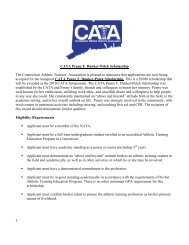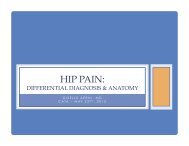Safe Weight Loss and Maintenance Practices in Sport and Exercise
Safe Weight Loss and Maintenance Practices in Sport and Exercise
Safe Weight Loss and Maintenance Practices in Sport and Exercise
Create successful ePaper yourself
Turn your PDF publications into a flip-book with our unique Google optimized e-Paper software.
Caloric <strong>in</strong>take should be based on the body weight goal• Just as athletes know they must acclimatize to environmental conditionsdur<strong>in</strong>g tra<strong>in</strong><strong>in</strong>g, we must encourage athletes to “get <strong>in</strong> shape”nutritionally. Persuade athletes <strong>and</strong> clients to adjust their weight <strong>and</strong>body composition dur<strong>in</strong>g the “pre-season”. “Get <strong>in</strong> shape to do the sportnot use the sport to get <strong>in</strong> shape” (Laquale, 1985).• Comb<strong>in</strong><strong>in</strong>g weight management <strong>and</strong> body composition goals with physicalcondition<strong>in</strong>g periodization goals will assist athletes <strong>and</strong> clients <strong>in</strong> reach<strong>in</strong>gweight goals.• There are metabolic estimation equations (to determ<strong>in</strong>e how manycalories per day the athlete should consume) which take <strong>in</strong>to considerationbody size, fat mass <strong>and</strong> FFM (muscle), age <strong>and</strong> the expenditure of energyfor activity.• (Table 4 <strong>in</strong> the position statement refers to two formulas (Harris-Benedict<strong>and</strong> the Miffl<strong>in</strong>-St.Jeor) which calculate total caloric need.)







